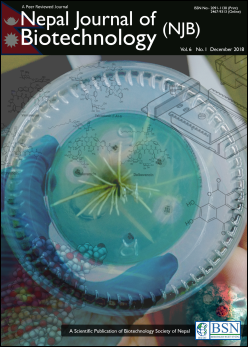Fecal carriage of Extended Spectrum β-Lactamases (ESBL) Producing Escherichia coli and Klebsiella spp. among School Children in Pokhara, Nepal
DOI:
https://doi.org/10.3126/njb.v6i1.22334Keywords:
Extended-spectrum β-lactamase (ESBL), E. coli, Klebsiella spp., children, NepalAbstract
Extended-spectrum β-lactamases (ESBL) producing microbes in recent years have been a major problem in developing countries like Nepal, with limited treatment options. This study aimed to determine the prevalence of ESBL producing E. coli and Klebsiella spp. in school children in Pokhara, Nepal. The study was conducted from June to October, 2015 at the microbiology laboratory of Manipal Teaching Hospital, Pokhara, Nepal. Antibiotic Susceptibility Test (AST) was done after isolation and identification of bacterial isolates. Then, presence of ESBL enzymes in E. coli and Klebsiella spp. were tested by combination disc diffusion test using cefotaxime and ceftazidime alone and with clavulanic acid. Out of total 309 school children, 211 (68%) bacterial isolates were detected from stool samples. Among them, E. coli and Klebsiella spp. were detected in 97 (46%) and 39 (19%) stool samples respectively. Bacteria isolated from 14 (5%) stool samples were multi-drug resistant (MDR) positive. After applying combined disk method, 88 (29%) isolates were found to be ESBL producer. Emerging prevalence rate of ESBL producing E. coli and Klebsiella spp. are major problem in medical history. Therefore, rapid need of surveillance for effective management of such MDR-strain is required.
Downloads
Downloads
Published
How to Cite
Issue
Section
License
Copyright Notice:
The manuscript submitted to NJB must be an original contribution, not previously published and should not be under consideration for publication elsewhere. When the manuscript is accepted for publication, the authors agree to automatically transfer the copyright of the article to the publisher. It should grant permission to any third party, in advance and in perpetuity, the right to use, reproduce or disseminate your article, according to the NJB copyright and license agreement.
Authors transfer copyright to the publisher as part of a journal publishing agreement but have the rights to: Share their article for Personal Use, Internal Institutional Use and Scholarly Sharing purposes, with the NJB applies the Creative Commons Attribution-NonCommercial CC BY-NC license to all the works we publish after Jun 2020 (Before it was CC BY-NC-ND). Under this license, authors agree to make articles legally available for reuse, without permission or fees, for virtually any non-commercial purpose. Anyone may remix, adapt, and build upon your work non-commercially, and although their new works must also acknowledge you and be non-commercial, they don’t have to license their derivative works on the same terms. More details on CC BY-NC refer to its Licence Deed and Legal Code.






